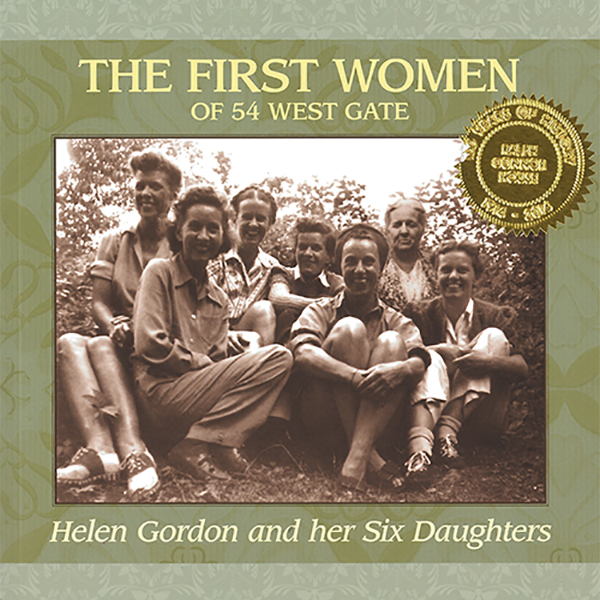by L. Blair Philpott
Parks Canada, Winnipeg
|
The First Women of 54 West Gate: Helen Gordon and her Six Daughters. Written and published by The Friends of Ralph Connor House Inc., Winnipeg, 2014, 104 pages. ISBN 9780993912726, $20.00 (paperback)
 Much has been written about the achievements of the men who came west toleave their mark. Job offers brought John Mark King and Charles William Gordon to the new, flourishing City of Winnipeg. King, with his family, left Toronto to be the first principal of Manitoba College in 1884. Gordon arrived ten years later to be the first minister of St. Stephen’s Presbyterian Church.
Much has been written about the achievements of the men who came west toleave their mark. Job offers brought John Mark King and Charles William Gordon to the new, flourishing City of Winnipeg. King, with his family, left Toronto to be the first principal of Manitoba College in 1884. Gordon arrived ten years later to be the first minister of St. Stephen’s Presbyterian Church.
Five years later, King’s daughter, Helen Skinner King, would marry Charles Gordon, whose second career as an adventure novelist, writing under the pen name of Ralph Connor, would bring him fame as a literary icon. It also brought the financial resources to build a mansion at 54 West Gate (in Winnipeg’s Armstrong’s Point neighbourhood) in 1914.
Unlike the renowned Charles Gordon, very little was known about Helen and the six daughters born to the Gordons. And that was the inspiration for another group of women—members of the Heritage House Conservation Committee of the University Women’s Club/Friends of Ralph Connor House. The First Women of 54 West Gate: Helen Gordon and her Six Daughters is a follow-up to the 2005 publication, 54 West Gate: Stories of Ralph Connor House. Both are handsome volumes, created with a variety of primary sources: archival documents; a wealth of anecdotal material from family, friends and colleagues; and lavish illustrations.
The collective writers—Irene Legg, Diane DeGraves, Dianne Shefford, Lorraine Cook, Agnes Collins, and Jan Christie—share a reverence for the Gordon legacy. As members of the University Women’s Club/Friends of Ralph Connor House, they are part of a team that has been caring for 54 West Gate since 1938, when the Gordons left shortly after Charles’s death.
The book opens with a preface written by Peter Carver, son of the eldest Gordon daughter, Mary Gordon Carver. It continues with chapters profiling Helen and each of the six daughters. The writing is accessible and targeted to reach a wide audience.
Helen was raised in a family with a deep commitment to education and the belief that women should have the same educational opportunities as men. After completing her Bachelor of Arts degree at Manitoba College in 1896, Helen spent a year studying English and German at the University of Edinburgh. She became a minister’s wife when the Social Gospel movement was sweeping through Protestant churches, emphasizing the Christian duty towards society and the need to work tirelessly at promoting social and spiritual well-being. As a result, Helen was immersed in parish activities and Presbyterian Church ventures with a focus on various pressing issues of the time—immigration, settlement, equality, and labour unrest. Charles and Helen’s family life was similarly large and ambitious in scope. Their first child, John King Gordon, followed the family path as a scholar, United Church minister, social democratic activist, and diplomat. John was followed by a succession of girls—Mary, Gretta, Lois, Ruth, Marjorie and Alison. Fifty-four West Gate was a high-energy household filled with music, dramatic pursuits and sporting activity. The Gordon children were guided with the values of family, service to the community, education and social justice. Each child received a university degree of their choice, travelled, and chose an adventure to pursue.
It is interesting to meet and get to know the Gordon women on paper. The common thread between them is service, and each, in her own way “worked to make the community stronger, more welcoming and inclusive.” Over time, the volunteer efforts of Helen Gordon and her generation evolved into the social service careers that many of her daughters would pioneer. This book serves as a reminder that much within our rich cultural and community life is ours today thanks to the incremental work of women like the Gordons.
Fifty-four West Gate has an enduring association with the Gordons, but it is “Birkencraig” on an island in Lake of the Woods, the summer home purchased by the family in 1906, which is a character in its own right. In the era when many Winnipeg families packed up to spend the entire summer at the cottage, the Gordons made the trip with both a piano and a cow, so that the children could practice their music and drink fresh milk! Readers familiar with the family cottage tradition will recognise the timeless appeal of the simple life, and “getting away from it all,” as the perfect tonic for the stresses of life. Most of the photographs in The First Women of 54 West Gate: Helen Gordon and her Six Daughters are from Birkencraig, which is still owned by the Gordon family and continues to be their special retreat. The photographs, rich source material for decades of cottage culture, capture the unique character of family leisure and affection within the beauty and serenity of nature. Family homes change over time and evolving circumstances, but memories from the family cottage are bound in a collective memory. Current Gordon family descendants still maintain that tradition today.
Proceeds from the sale of The First Women of 54 West Gate: Helen Gordon and her Six Daughters support the ongoing preservation of Ralph Connor House.
We thank Clara Bachmann for assistance in preparing the online version of this article.
We thank S. Goldsborough for assistance in preparing the online version of this article.
Page revised: 15 April 2020